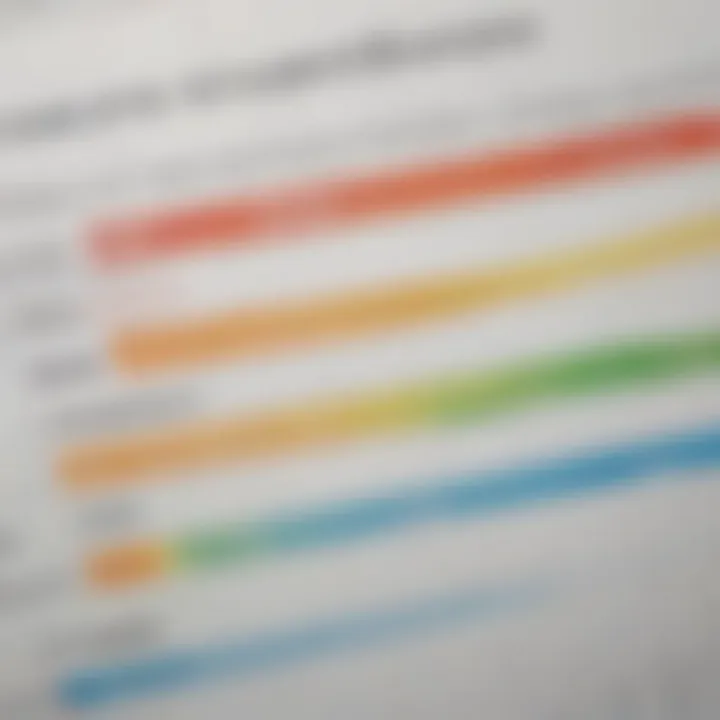Choosing the Best Federal Student Loan Repayment Plan


Intro
Navigating the world of federal student loans can feel like walking through a labyrinth, particularly when it comes to repayment. With various plans and options available, determining the optimal path forward is crucial for managing debt effectively. Borrowers need to dig deep into their personal situations, understanding each plan's features while weighing the long-term costs and benefits. This lays the groundwork for a more informed decision-making process, making sure the chosen repayment option aligns with individual financial goals.
Understanding the Landscape
Before diving into the specifics, it’s important to recognize the broader context. Higher education often comes with significant financial burdens, and understanding different repayments is vital for those looking to enhance their careers without drowning in debt. With interest rates varying and financial circumstances changing, those numbers may not always add up neatly. Therefore, adaptation is key.
"Choosing the right repayment plan can be a make-or-break factor in your financial future."
Investment Dictionaries
Understanding some key financial terminology can ease the navigation process considerably.
Common Financial Terms
- Annual Percentage Rate (APR): Reflects the total cost of borrowing annually, including interest and fees. It’s vital to know this figure to assess the long-term impact of loans.
- Grace Period: After graduation or leaving school, this period allows borrowers time before starting repayment.
- Loan Forgiveness: A term that denotes the cancellation of a borrower’s debt contingent upon specific conditions being met, often tied to public service employment.
Advanced Investment Terminology
- Income-Driven Repayment Plans: These plans adjust monthly payments according to a borrower’s income and family size, helping to lighten the immediate financial burden.
- Capitalized Interest: When unpaid interest is added to the principal loan amount, increasing the overall cost of borrowing.
A firm grasp of these terms provides crucial context for later discussions about repayment options. Without this vocabulary, making decisions about federal student loans might become even more challenging.
Expert Advice
Informed strategies are instrumental in choosing the right repayment plan. Here, expertise comes into play.
Tailored Repayment Strategies
Each borrower’s situation is unique; thus, the one-size-fits-all approach won’t fly. Consider creating personalized financial plans:
- Evaluate Financial Status: Identify monthly income, fixed expenses, and discretionary spending. This helps streamline which repayment plan fits best.
- Utilize Online Calculators: These tools can project total repayment costs under various plans, helping borrowers visualize financial outcomes.
Risk Management Techniques
Understanding the risks associated with each repayment plan can prevent pitfalls:
- Adjusting to Life Changes: Consider planning for potential changes to income (e.g., job loss). Different plans offer varying levels of flexibility.
- Prioritizing Higher Interest Loans: Focus on paying off those loans first to minimize the overall interest paid over time.
The financial landscape surrounding student loans can seem daunting. Yet, by leveraging the right information and strategies, borrowers can navigate it with greater confidence, ensuring they're not just making payments, but building a secure financial future while fulfilling educational aspirations.
Prelude to Federal Student Loan Repayment Plans
Understanding the landscape of federal student loan repayment plans is crucial for anyone who has taken out loans for education. The way these loans are structured can significantly impact a borrower’s financial future. Each repayment plan offers different terms, interest rates, and repayment periods, making it vital for borrowers to comprehend their options.
Choosing the right repayment plan is not merely about selecting what seems convenient; it involves a strategic approach that considers personal circumstances, financial goals, and even future life events. At the center of this discussion is the concept that a well-informed choice can lead to substantial savings over time. Ignoring this choice, on the other hand, can result in unnecessary financial stress and could even prolong the debt burden unnecessarily.
Understanding Federal Student Loans
Federal student loans are designed to provide support to students pursuing their education. Unlike private loans, these loans usually come with lower interest rates and more flexible repayment options. Understanding the nuances between various loan types—like Direct Subsidized, Direct Unsubsidized, and PLUS loans—is key. For instance, subsidized loans cover interest while the student is enrolled in school, while unsubsidized loans start accruing interest immediately.
Borrowers must familiarize themselves with the terms of their loans. Often, they can find useful information about their loan balances, types, and servicer through the National Student Loan Data System (NSLDS).
Importance of Choosing the Right Plan
The importance of selecting the right repayment plan cannot be overstated. An ideal plan not only ensures manageable monthly payments but can also minimize the total interest paid over the life of the loan. Each borrower’s situation is unique, and thus the plan that suits one individual may not be ideal for another.
Consider these factors when making your choice:
- Financial Stability: How much can you afford to pay each month?
- Income Variability: Do you expect your income to increase, decrease, or remain stable?
- Loan Forgiveness Options: Are you aiming for loan forgiveness programs, and if so, which repayment plan aligns with that goal?
To illustrate, let’s consider a scenario. A recent graduate, Emily, has a total student loan debt of $30,000. Upon graduation, she has secured a job, but her starting salary is modest. If Emily selects the Standard Repayment Plan, her monthly payments might be higher than what she can handle comfortably. On the other hand, if she opts for an Income-Driven Repayment Plan, her payments could be reduced significantly based on her income level, providing her much-needed financial breathing room.
"Choosing the right repayment plan is akin to charting a course in uncharted waters; the right navigation can lead you to safety and savings, while the wrong path can be costly."
Assessing one’s financial situation holistically is essential when determining the most suitable repayment plan. Ultimately, an informed choice is always the best path forward.
Types of Federal Student Loan Repayment Plans
Understanding the various types of federal student loan repayment plans is crucial for borrowers looking to manage their debt effectively. Each plan has its own set of features and benefits that can cater to different financial situations and life circumstances. Choosing the right repayment strategy can help you save money over time and align your repayment schedule with your income patterns.


Exploring these options not only empowers you but also paves the way for informed financial decision-making. With a clear blueprint, you can minimize stress and avoid potential pitfalls associated with student loan repayment. Let's delve into each of these plans to see which might fit your unique situation best.
Standard Repayment Plan
The Standard Repayment Plan is the most straightforward option available. Under this plan, borrowers pay a fixed amount each month, ensuring that the loan is fully paid off within a decade. While the steady payment schedule simplifies budgeting, borrowers should consider their personal finances and whether a predictable payment plan aligns with their fiscal needs.
Benefits of the Standard Repayment Plan include lower overall interest costs, as the loan is paid off earlier compared to other plans. However, for those with lower incomes or unpredictable financial situations, making fixed monthly payments can feel like a heavy burden.
Graduated Repayment Plan
For those anticipating an income increase in the future, the Graduated Repayment Plan might be an attractive option. This plan starts with lower payments that gradually increase every two years. It's designed for borrowers who expect their financial situations to improve over time.
The key characteristic of this plan is its flexibility. As your income grows, your ability to pay more increases, reducing the financial strain early on. However, the total interest paid over the loan's lifetime can be higher, as initially, the payments do not cover the accruing interest.
Extended Repayment Plan
The Extended Repayment Plan is tailored for borrowers with larger loans. This option allows for a longer repayment period—up to 25 years. This plan offers either fixed or graduated payment routes.
Importantly, many borrowers find this beneficial during times of financial uncertainty. The main downside, though, is that stretching out the repayment can lead to significantly higher interest costs over time.
Income-Driven Repayment Plans
Income-Driven Repayment Plans (IDR) aim to make payments more manageable based on a borrower's income and family size. These plans can be especially beneficial for those entering professions with modest starting salaries or those who find themselves in financial distress. There are four primary types of IDR plans:
Revised Pay As You Earn (REPAYE)
REPAYE is particularly noteworthy due to its focus on income. Payments are capped at 10% of discretionary income, which provides a substantial relief for those who might otherwise struggle to meet their loan obligations. Additionally, REPAYE offers loan forgiveness after 20 years, or 25 years if the loans were for graduate school.
The plan's key benefit is its broad eligibility, as it includes borrowers regardless of when they took out their loans. However, a potential downside is that borrowers can end up with a larger balance due to interest capitalization if payments do not fully cover interest charges.
Pay As You Earn (PAYE)
Similar to REPAYE, PAYE caps monthly payments at 10% of discretionary income, but it comes with stricter eligibility criteria, typically favoring those who took loans out after October 2007. The key characteristic of PAYE is its focus on affording borrowers the chance to manage their obligations more effectively when financial hurdles arise.
One unique feature of PAYE is that it provides forgiveness after 20 years of qualifying payments. However, if the borrower's income increases, so could their payment, which might lead to feelings of financial strain despite the initial benefit.
Income-Based Repayment (IBR)
Another option for those with tight finances is Income-Based Repayment (IBR). Monthly payments here are also capped at a percentage of discretionary income—15% for new borrowers on or after July 1, 2014, and 10% for those earlier. A highlighted benefit is the potential for loan forgiveness after 20 or 25 years of payments, depending on when the loans were taken.
While IBR can provide a pathway to manage payments, borrowers might still find themselves accruing additional interest, leading to an increased overall financial burden if they rely on lower payments for a prolonged period.
Income-Contingent Repayment (ICR)
The Income-Contingent Repayment Plan takes borrower income and family size into account every year. It also caps payments at 20% of discretionary income or the amount the borrower would pay under a fixed 12-year plan. Key here is the flexibility for changing financial situations, making it a recommendation for those who might see income fluctuations.
While this plan accommodates shifts in earnings, it can lengthen the repayment duration and heighten overall costs, which may be disadvantageous in some cases. Borrowers need to carry out a close assessment of their financial situation before committing to this route.
Considering all these repayment plans, it’s essential to evaluate which resonates with your current financial landscape and future goals. Understanding these specifics can provide clarity as you decide on the path that best fits your needs.
Eligibility for Different Repayment Plans
Understanding eligibility for various federal student loan repayment plans isn’t just an afterthought; it’s a critical piece of the puzzle that can shape your financial future. Choosing the right plan can either lighten your monthly burden or extend the repayment period significantly, depending on your circumstances.
When you’re looking at student loans, knowing who qualifies for which repayment options can save you time and uncover savings you may not have initially considered. Not every plan fits all borrowers, and navigating these waters requires careful consideration of your individual financial picture, loan types, and obligations.
Criteria for Standard and Graduated Plans
The Standard and Graduated repayment plans have specific criteria that borrowers must meet. Standard Repayment is straightforward: borrowers can pay off loans in a fixed amount over a ten-year term. Generally, this option is available to everyone with federal student loans, making it an accessible choice. If you opt for this, expect consistent monthly payments, which can help streamline budgeting.
On the other hand, the Graduated Repayment Plan is designed for those expecting their income to rise over time. This plan starts with lower payments that increase every two years, also spread over a span of ten years. If you think your future income will be on an upward trajectory, this may be an appealing option as it allows for more manageable payments in the beginning phase. However, it’s essential to remember that this means higher payments later on, which could pinch your finances if your income growth doesn’t pan out as expected.
Income-Driven Plans and Financial Circumstances
Income-Driven Repayment plans are a game changer, especially for those dealing with fluctuating financial situations. Unlike the Standard and Graduated plans, these options consider your discretionary income. Plans such as Revised Pay As You Earn (REPAYE), Pay As You Earn (PAYE), Income-Based Repayment (IBR), and Income-Contingent Repayment (ICR) cater primarily to borrowers who have variable or reduced incomes.
To enroll in such plans, you generally need to demonstrate financial hardship, which often means low income compared to your loan balance. The beauty of these plans is that your monthly payments can be as little as 10% to 15% of your discretionary income, capped at certain limits. This helps maintain financial stability and avoid defaulting on loans as your circumstances change. Importantly, while these plans can lead to forgiveness after a set period (usually 20 or 25 years), they can also result in higher overall payments due to interest capitalization.
Impact of Loan Type on Eligibility


Not all loans are created equal when it comes to repayment plans. The type of loan—be it Direct Subsidized, Direct Unsubsidized, Perkins, or PLUS loans—can significantly affect which repayment options you can choose.
For example, while Direct Loans generally have a wider range of repayment options, certain plans aren't available for PLUS loans or Perkins Loans. This complicates things for some borrowers, especially those who have a mix of loan types. It is crucial to understand the specifics surrounding your loans to make informed decisions.
One pertinent consideration is that if you default on any of your loans, your eligibility for some repayment plans may be restricted until you resolve that default. So, keeping all your loans in good standing is essential.
In summary, knowing the ropes of loan eligibility can lead to smarter financial moves in managing your student loans. Each repayment plan offers unique benefits tailored to different types of borrowers.
Ultimately, understanding these options requires not only a look at your current financial status but also a consideration of where you envision your financial life going.
Assessing Your Financial Situation
In deciding which federal student loan repayment plan is right for you, taking a step back to assess your financial situation is crucial. An accurate understanding of your income, expenses, and overall financial health paves the way for making well-informed decisions. This process is akin to trying to navigate a maze without a map; without clear insight into what you’re working with, it’s easy to get lost and find yourself in undesirable circumstances.
Evaluating your financial situation involves not just looking at what's in your bank account, but also factoring in various elements that impact your financial well-being.
Here are some key considerations that underscore the importance of this aspect:
- Creating a Baseline: First and foremost, knowing where you currently stand financially sets the tone. This means identifying your net income, which is your income after taxes and other deductions. High earners sometimes overlook how much actually comes home. Understanding this can dramatically influence what repayment plan is best.
- Understanding Fixed vs. Variable Expenses: Monthly bills come in two flavors—fixed and variable. Fixed expenses, like rent or mortgage payments, remain relatively the same, while variable expenses can fluctuate. Grasping these differences is essential for anticipating your monthly cash flow.
- Determining Disposable Income: After marking down all your expenses, you'll be left with your disposable income. This is where the rubber meets the road in terms of choosing a repayment plan. You need a solid estimate of how much you can reasonably allocate to loan payments each month.
- Considering Lifespan of Loans: Allocating budget resources to your loans entails looking at how long you want to take to pay them off. High-interest loans may eat away at your finances over time, leading you to seek quicker repayment plans despite higher monthly payments.
More than simply crunching numbers, it’s about knowing the unique characteristics that inform the specific challenges to your financial structure and how they align with different repayment plans.
Informed decisions hinge on clarity about your finances. Recognizing gaps between income and expenses can help determine how much leeway you have while repaying loans.
Identifying Income and Expenses
Identifying your income and expenses is your first step in mapping out your financial landscape. Start by listing all sources of income—this may include your job salary, freelance work, dividends from investments, and any other form of income. Be meticulous and ensure that you list everything. Sometimes, side gigs can bring in surprising amounts that, when overlooked, can impact monthly cash flow calculations significantly.
Next, chart out your monthly expenses. This is where a widespread awareness of your financial habits is necessary. You can break these down into:
- Essential Expenses: These include basics like housing, food, and necessary utilities. Without these, it’s hard to maintain an adequate standard of living.
- Discretionary Expenses: This category includes things like dining out, entertainment, and shopping. While these aren’t strictly “needed” expenses, they contribute to your quality of life.
- Debts Obligations: Don’t forget about existing obligations like credit cards or personal loans that might also require payment each month.
Taking stock of these components helps build a clearer picture of where your money goes, subsequently informing which repayment plan might best suit your current situation.
Evaluating Short-term vs. Long-term Goals
Your financial goals can significantly influence the loan repayment strategy. It’s important to differentiate between short-term needs and long-term aspirations. Each of these paths carries its own implications for repayment choices.
- Short-term Goals: Perhaps you want to buy a new car, or you’re planning a big trip within the next couple of years. If short-term financial commitments are on your doorstep, a repayment plan that allows for lower monthly payments might be favorable. This way you can allocate more resources towards immediate goals. Lower monthly outlays could buy you the breathing room you need.
- Long-term Aspirations: If you’re looking to invest in a home or retirement, consider how your repayment plan choice fits into those broader objectives. A plan that prioritizes faster repayment might be sensible in this context as it can clear your debt sooner, enabling you to invest your surplus funds into wealth-building activities.
Ultimately, balancing these goals involves making trade-offs. You might consider how sacrificing a bit now could yield significant returns down the road. Careful thought in this area provides clarity in decision-making about which repayment option aligns with your financial aspirations.
Therefore, reviewing your short-term versus long-term goals will help you avoid potential pitfalls while setting up a repayment strategy that doesn’t just help pay down your student loans, but enhances your financial health overall.
Making an Informed Decision
Making an informed decision about federal student loan repayment plans is of paramount importance. It’s the difference between struggling to pay off debt for years and finding a manageable solution that fits your unique situation. Every borrower’s financial landscape is as distinctive as a fingerprint, influenced by income, expenses, and personal life goals. Thus, navigating these waters requires clarity and careful consideration.
Comparing Repayment Options
When it comes to comparing repayment options, it’s essential to look at each plan’s features, benefits, and potential downsides. Here are some key aspects to keep in mind:
- Standard Repayment Plan: Ideal for borrowers who can afford consistent monthly payments. The term is usually 10 years, which means you pay off your loans relatively quickly.
- Graduated Repayment Plan: Suited for those starting with lower incomes that expect to rise. Payments start lower and gradually increase, making it easier to manage in the early years.
- Extended Repayment Plan: This option stretches payments over 25 years. This is useful for borrowers who hold a substantial amount of debt and need smaller, more manageable monthly payments.
- Income-Driven Repayment Plans: These plans adjust according to your income. They offer flexibility for those with fluctuating finances:
- Revised Pay As You Earn (REPAYE)
- Pay As You Earn (PAYE)
- Income-Based Repayment (IBR)
- Income-Contingent Repayment (ICR)
By diving into each repayment option and understanding how they align with your financial capacity, you can shift from confusion to confidence. Make sure to visualize any implications a longer repayment term might have on the interest accumulating over time. Essentially, you want to balance monthly affordability with the total cost over the long term.
Seeking Financial Advice
Whether you’re knee-deep in student loans or just beginning to explore repayment options, consulting a financial advisor can be a game-changer. A qualified professional brings experience and objectivity that you might not possess. Here are key benefits to consider:
- Personalized Guidance: An advisor can analyze your financial situation and help you find a plan tailored to your needs. This tailored approach can lead to substantial savings.
- Avoiding Common Pitfalls: With the learning curve ahead, a financial expert can steer you clear of costly mistakes, like choosing an unsuitable repayment plan.
- Updated Knowledge: Laws and policies related to student loans can change. An advisor stays current on developments that might affect your options and strategies.
"Consult a financial advisor who gets your goals straight. A wise decision today can soak up the stress of repayment down the road."
There are multiple avenues to seek this advice. Whether you choose a local firm or jump into online platforms that offer consultations, the investment is generally worth it in the long run. With their insights, you can truly weigh your options and feel well-equipped to tackle your student loan repayment plan head on.
Potential Challenges and Solutions


Navigating the realm of federal student loan repayment isn't always a smooth ride. Challenges can crop up unexpectedly, making it essential for borrowers to think ahead and craft strategies to tackle potential roadblocks. This section emphasizes the significance of being prepared for financial hardships and sudden changes in employment, as they can dramatically influence a borrower's ability to manage student loans effectively. By equipping oneself with knowledge and adaptive strategies, one can turn these hurdles into manageable obstacles.
Dealing with Financial Hardship
When financial trouble strikes, the immediate instinct might be to panic, but this may lead to rash decisions that can worsen the situation. Recognizing early warning signs of hardship, like struggling to meet basic living expenses or feeling overwhelmed by monthly payments, is vital. Understanding the options available during such times can be a game changer.
Borrowers might find relief through several avenues:
- Income-Driven Repayment Plans: These plans adjust monthly payments based on income and family size. If your earnings take a nosedive, this could mean lower payments.
- Forbearance or Deferment: These options allow for temporary suspension of payments. However, it’s crucial to remember that interest may still accrue during this time.
- Loan Forgiveness Programs: Some may qualify for forgiveness after years of service in certain professions, especially public service roles.
"Planning for the worst while hoping for the best can save you from sinking into a financial quagmire."
One cannot underestimate the power of budgeting during tough times. Keeping a close eye on expenses and finding ways to minimize costs can create a buffer, making it easier to handle loan payments. Joining support groups or forums can also help in sharing experiences and solutions with those in similar situations.
Navigating Changes in Employment Status
A shift in employment status—whether that's a layoff, career change, or even a promotion—can drastically alter one’s financial landscape. Understanding how to approach student loan payments during these transitions is crucial.
For instance, if someone loses their job, it’s paramount to:
- Communicate with Loan Servicers: Contact your loan servicer immediately to discuss options. Ignoring the issue can lead to missed payments and damage to your credit.
- Review Unemployment Benefits: Some people may be eligible for unemployment insurance, which can help cover living expenses while you search for new work.
On the flip side, if someone lands a better-paying job, they may also need to:
- Reassess Repayment Plans: With an increased income, changing to a different repayment plan may save on interest or pay off loans faster.
- Consider Additional Payments: If finances allow, making extra payments toward the principal can reduce overall interest paid over the life of the loan.
The adaptability of your repayment strategy is paramount, serving as the cornerstone for maintaining financial stability. By acknowledging the potential challenges and crafting preemptive solutions, individuals can stay afloat in the turbulent waters of student loan repayment.
The Importance of Staying Informed
Keeping up with the latest developments regarding federal student loan repayment is more than just a good idea; it’s essential for anyone managing student debt. This is a landscape that changes frequently, influenced by legislation, economic conditions, and even new initiatives from the Department of Education. It’s vital for borrowers to stay current on these shifts, as this knowledge empowers them to choose the best repayment plan tailored to their circumstances.
Being informed means understanding how different repayment plans may be affected by new laws or changes in policy. For instance, a proposed overhaul to the Income-Driven Repayment plans could significantly alter the payments you make — whether they decrease or increase. Additionally, certain forgiveness programs can get modified, especially during elections or economic crises. Taking the time to stay updated on these elements can save borrowers a lot of hard-earned money in the long run.
Moreover, it places the borrowers in a stronger position when dealing with loan servicers. Knowing your options gives you leverage in discussions about payment configurations. It’s scary to think someone could leave tens of thousands of dollars on the table, purely by not having the latest information. Don't be that person.
Monitoring Changes in Laws and Policies
The world of federal student loans isn’t stagnant; it ebbs and flows. Policymakers regularly introduce new laws or amend existing ones. For example, if you were unaware of revised qualifications for Public Service Loan Forgiveness, you might miss out on a full cancellation of your student debt. Keeping tabs on changes ensures you’re not left in the lurch.
Key areas to monitor include:
- Interest rates: Fluctuations can impact repayment amounts significantly.
- Forgiveness programs: These sometimes have changing eligibility criteria or caps.
- Repayment plan structures: New options or modifications to existing plans could work better based on your financial circumstances.
It’s beneficial to set up alerts or follow reliable sources like the Department of Education's newsletters or dedicated forums on Reddit. By engaging with current discussions, you gain insight into both general trends and specific updates.
How to Remain Engaged with Financial Education
In today’s fast-moving world, continuing financial education about federal loans is not a luxury; it's a necessity. Lifelong learning enhances one’s understanding of personal finance concepts and loan management.
One way to stay engaged is to regularly consult credible resources. Websites like Wikipedia and Britannica offer foundational and updated knowledge on student loans and various repayment plans. These can serve as excellent starting points for research.
Consider these methods for continuous learning:
- Attend webinars and workshops: These often provide up-to-date insights and answers to specific questions.
- Follow financial blogs: Analysts and experts regularly discuss trends and practical tips.
- Join online discussion groups: Platforms like Reddit have communities focused on financial topics where you can share experiences and advice.
- Utilize social media: Facebook has various groups dedicated to financial education where members share invaluable resources and experiences with student debt.
Engaging in financial education keeps you well-prepared for any surprises that come your way, and provides clarity and confidence when making decisions regarding your loans. Remember, knowledge is power!
Finale
In navigating the intricate landscape of federal student loan repayment, the importance of determining the right repayment plan cannot be overstated. A well-chosen plan can significantly impact a borrower’s financial future. Each individual’s financial situation is unique, making it crucial to reflect on personal circumstances when selecting a repayment strategy.
Reflecting on the Best Plan for Each Individual
Finding the ideal repayment option requires a thoughtful assessment of several factors. Start by evaluating your income, expenses, and future financial goals. As everyone's situation is distinct, here are a few key points to consider when examining repayment plans:
- Income Levels: Analyze your current income against your expenses to understand what you can afford in monthly payments. This assessment also helps in identifying whether you might qualify for an income-driven repayment plan.
- Loan Amounts: Consider the total amount owed on your student loans; larger debts may benefit from plans that offer extended repayment periods.
- Career Trajectory: If your career path is expected to lead to higher earnings in the future, a graduated repayment plan might present a viable option, allowing for initial lower payments that increase over time.
- Financial Obligations: Take into account other financial responsibilities such as rent, utilities, and family obligations to avoid stretching your budget too thin.
Ultimately, there's no 'one-size-fits-all' when it comes to repayment plans. Each individual must weigh options carefully, reflecting on their personal journey and future aspirations.
Resources for Further Assistance
Staying informed and seeking assistance is vital for making sound financial decisions. Here are some valuable resources:
- Federal Student Aid (federalstudentaid.ed.gov): The primary source for all things related to federal student loans, including details on various repayment plans.
- National Student Loan Data System (NSLDS) (nslds.ed.gov): This site provides a comprehensive overview of your federal loans, helping you keep track of your borrowing.
- Reddit (reddit.com/r/personalfinance): A community where people share their repayment experiences and strategies that might give you fresh ideas.
- Financial Advisors: Consult with a financial professional who can provide guidance tailored to your specific financial situation.
Equipped with the right information and a clear understanding of your individual responsibilities, you can make informed decisions that align with both your present circumstances and future goals. Remember, the process may seem daunting, but leveraging available resources can put you on a path towards effective loan repayment and financial stability.







